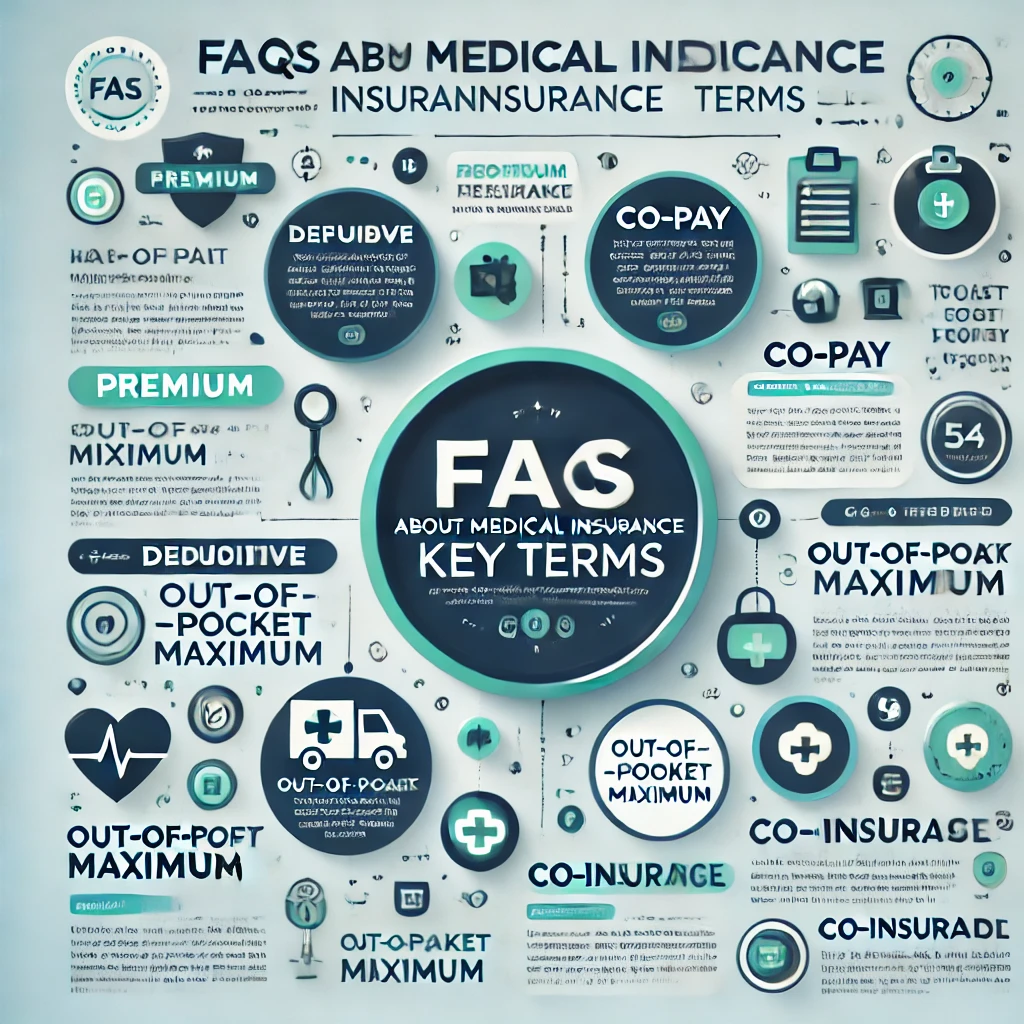Medical Insurance Key Terms Explained: Avoid Hidden Costs
Navigating medical insurance key terms can feel overwhelming, but understanding them is essential. From premiums to deductibles and co-pays, these terms directly impact your healthcare costs. In this guide, I’ll break down the most important terms so you can confidently manage your insurance and avoid costly surprises.
Key Takeaways
- Premiums: Monthly cost to keep your insurance active; doesn’t cover services.
- Deductibles: Out-of-pocket amount paid before insurance starts covering costs.
- Co-Pays: Fixed fees for doctor visits, urgent care, and prescriptions.
- Co-Insurance: Cost-sharing percentage you pay after meeting the deductible.
- In-Network Providers: Use them to avoid higher costs and balance billing surprises.
- Out-of-Pocket Maximum: The total you’ll pay annually before insurance covers 100%.
- EOB: Review this document to spot errors and ensure accurate billing.

What is a Medical Insurance Premium?
Let’s start with the one term that’s usually not as intimidating: the premium. This is the amount you pay out of pocket—often monthly or from your paycheck—to maintain your insurance coverage.
Think of your premium as the cost of having the safety net of insurance, even if you never use it. Here’s how it works:
- If you have insurance through your employer, your premium is usually deducted directly from your paycheck.
- If you purchased your insurance through the marketplace (aka “the exchange”), you pay this amount yourself—typically on a monthly basis.
- For Medicare patients, premiums are often deducted from your monthly Social Security benefits.
Key takeaway? Your premium is what keeps your coverage active, but it doesn’t cover services like doctor visits or hospital stays—that’s where the deductible and co-pays come in.
The Dreaded Deductible: What You Pay Before Insurance Helps
The deductible is one of the most misunderstood medical insurance key terms. It’s the amount you have to pay out of pocket before your insurance starts covering any of your bills (beyond preventive care, which is often free).
For example, if your deductible is $3,000:
- You’ll need to pay $3,000 out of your own pocket for medical services before your insurance begins paying its share.
- This is on top of your premiums, so it’s a completely separate cost.
Here’s where it gets a little more palatable:
If you visit doctors or hospitals in-network, the insurance company forces providers to apply discounted rates to your bills. These discounts help you pay less than you would if you didn’t have insurance. Plus, every dollar you pay toward a bill gets applied to your deductible balance.
Say your deductible is $3,000, and you receive a $200 bill for an in-network visit. Once you pay that $200, your remaining deductible drops to $2,800. And while many healthy people never meet their deductible (which can be frustrating), this system ensures you’re getting some level of benefit for your premiums.
Co-Pay: What You Pay at Each Visit
Ah, the co-pay—probably the most familiar of all the medical insurance key terms. Your co-pay is the fixed amount you pay at the time of service when you see a doctor, specialist, or even visit urgent care.
Here’s how it works:
- Primary care co-pay: Usually the lowest amount (e.g., $20–$50).
- Specialist co-pay: Slightly higher (e.g., $40–$75).
- Urgent care co-pay: More expensive (e.g., $75–$100).
- ER co-pay: The highest of them all (e.g., $100–$300).
It’s important to note that co-pays are mandatory. Your doctor’s office has a contract with your insurance company that requires them to collect the co-pay at the time of service. If you’re unable to pay upfront, the office might bill you later—but this isn’t always an option, and it’s a hassle for everyone involved.
So, as a patient, it’s crucial to know your co-pay amounts for different types of visits ahead of time.
Co-Insurance: Sharing the Costs After Your Deductible
Once you’ve met your deductible, co-insurance kicks in. Co-insurance is a cost-sharing agreement between you and your insurance company.
For example:
- If you have an 80/20 plan, the insurance company covers 80% of your bill, and you’re responsible for the remaining 20%.
- If you have a 70/30 plan, the insurance covers 70%, and you cover 30%.
Let’s say you’ve already hit your deductible, and you have an 80/20 plan:
- Your doctor visit costs $1,000.
- The insurance company pays $800.
- You pay $200 out of pocket (your 20%).
Pro tip: Use a Health Savings Account (HSA) or Flexible Spending Account (FSA) to cover your share of co-insurance costs. These accounts allow you to pay with pre-tax dollars, saving you money in the long run.

In-Network vs. Out-of-Network: Why It Matters
One of the most important medical insurance key terms to understand is the difference between in-network and out-of-network providers.
- In-network providers: These doctors, hospitals, and clinics have contracts with your insurance company to offer discounted rates. Using in-network providers keeps your costs lower and ensures your insurance plan pays its share.
- Out-of-network providers: These providers don’t have contracts with your insurance company. Bills from out-of-network providers are typically higher, and your insurance may cover only a small portion—or none at all.
You might also have a separate deductible for out-of-network care, which can add to your costs.
Understanding These Terms is Empowering
Understanding medical insurance key terms like premiums, deductibles, co-pays, and co-insurance isn’t just about avoiding surprise bills—it’s about taking control of your healthcare. When you know how your insurance works, you can make informed decisions, ask better questions, and feel more confident about managing your benefits.
Unlocking More Essential Medical Insurance Key Terms
Now that we’ve tackled the basics—premiums, deductibles, co-pays, co-insurance, and the whole in-network vs. out-of-network debate—let’s level up your understanding of medical insurance key terms.
These terms can feel overwhelming at first, but once you understand them, you’ll have the confidence to navigate your insurance plan like a pro. Trust me, knowing what you’re signing up for can save you from countless headaches, surprise bills, and hours on hold with customer service.

Out-of-Pocket Maximum: Your Financial Safety Net
One of the most misunderstood but absolutely crucial medical insurance key terms is the out-of-pocket maximum. This is the maximum amount you’ll pay in a benefit year for covered healthcare expenses, including deductibles, co-pays, and co-insurance.
Here’s the magic of it: Once you hit this amount, your insurance company starts covering 100% of your medical costs for the rest of the year.
Let’s break it down:
- You have a $3,000 deductible, 80/20 co-insurance, and a $6,000 out-of-pocket maximum.
- You’ve already paid $3,000 to meet your deductible. That leaves $3,000 more to reach your out-of-pocket maximum.
- For every bill after the deductible, you’ll pay 20% (your co-insurance) until you hit that $6,000 max.
Once you’ve reached the out-of-pocket maximum, your insurance covers everything—yes, EVERYTHING—at 100% for the rest of the year.
Why does this matter? It protects you from runaway medical costs in case of emergencies or chronic conditions.

Health Savings Accounts (HSA) vs. Flexible Spending Accounts (FSA)
If you have a high-deductible health plan (HDHP), chances are you’ve heard of Health Savings Accounts (HSA) or Flexible Spending Accounts (FSA). These two tools can make managing your healthcare costs a lot easier—but they work a little differently.
| Feature | Health Savings Account (HSA) | Flexible Spending Account (FSA) |
|---|---|---|
| Who qualifies? | Only people with high-deductible health plans (HDHPs). | Available with most employer health plans. |
| Contributions | Made with pre-tax dollars, and often, employers contribute. | Made with pre-tax dollars, but usually no employer help. |
| Rollover funds? | Yes! Funds roll over year to year and can even grow with interest. | No. Most FSAs are “use it or lose it” by the year-end. |
| Can you invest it? | Yes. HSAs act like mini savings accounts or retirement funds. | No. FSAs are more like a short-term reimbursement tool. |
| Eligible expenses? | Medical, dental, vision, prescriptions, and some over-the-counter items. | Same as HSAs, but rules vary slightly by employer. |
Both HSAs and FSAs are great options to pay for out-of-pocket costs like deductibles, co-pays, and co-insurance, but HSAs are especially awesome if you’re looking for a long-term savings tool for healthcare costs.
Pro Tip: If your employer offers an HSA with matching contributions, grab it! It’s essentially free money for your healthcare needs.
Specialist Referrals: Do You Need One?
Here’s another sticky topic: Do you need a referral to see a specialist? This depends entirely on your insurance plan type, and it’s a key piece of the medical insurance key terms puzzle.
- HMO (Health Maintenance Organization) plans typically require referrals. If you need to see a cardiologist, allergist, or any other specialist, you’ll first have to see your primary care doctor (PCP) for a referral. No referral = no coverage.
- PPO (Preferred Provider Organization) plans usually don’t require referrals. You can make an appointment with a specialist directly, though it’s always a good idea to check if they’re in-network to save money.
Why do referrals matter? Insurance companies use referrals to control costs and make sure you really need that specialist visit. It’s a hassle, yes, but ignoring this step can result in denied claims, leaving you on the hook for the full bill.
Explanation of Benefits (EOB): Decoding the Insurance Paperwork
Every time you visit a doctor or have a medical service, you’ll receive a mysterious piece of paper (or email) from your insurance company called an Explanation of Benefits (EOB). It’s NOT a bill, but it’s one of the most important documents to review.
Here’s what it includes:
- The total cost of the service: What your doctor or hospital charged.
- Insurance discounts: How much the provider has to write off because they’re in-network.
- What your insurance covered: The portion of the bill your insurance paid.
- What you owe: Your portion, which may include co-pays, co-insurance, or deductible amounts.
Pro Tip: Always compare your EOB to the bill you receive from your doctor’s office. If the numbers don’t match, call your insurance company to clarify. Mistakes happen more often than you think.
Prior Authorizations: The Gatekeeper of Insurance Approval
Some medical services or prescriptions require prior authorization before your insurance company will agree to cover them. This means your doctor has to submit a formal request explaining why the service or medication is medically necessary.
Examples of services that often need prior authorization:
- MRIs, CT scans, and other imaging.
- Expensive medications, especially brand-name drugs.
- Surgeries or specialty treatments.
If your doctor’s office doesn’t secure the prior authorization before the service, your insurance might deny the claim—and guess who gets stuck with the bill? Yup, you.
How to avoid issues? Always double-check with your doctor’s office and insurance company to confirm prior authorization has been approved before moving forward.
Out-of-Network Deductibles: The Hidden Cost
Here’s a curveball you might not see coming: Many insurance plans have separate deductibles for out-of-network care.
Let’s say your plan has:
- A $3,000 in-network deductible.
- A $6,000 out-of-network deductible.
If you see an out-of-network doctor, you’ll need to pay the $6,000 deductible before your insurance covers anything. That’s on top of the higher costs you’ll face for seeing a provider who isn’t contracted with your insurance.
Moral of the story? Stick to in-network providers whenever possible.
Bonus Tip: Double-Check Your Annual Enrollment!
Every year, insurance plans update their coverage rules, premiums, and benefits. Make it a habit to review your plan during the annual open enrollment period.
Here’s what to look for:
- Changes to your deductible or out-of-pocket maximum.
- Updated provider networks (doctors can drop in and out of networks).
- Any new co-pay or co-insurance structures.
Being proactive during enrollment can save you money and help avoid unpleasant surprises.
Advanced Medical Insurance Key Terms You Need to Know
Alright, let’s dive even deeper into the world of medical insurance key terms. If you’ve made it this far, you’re officially leveling up your insurance knowledge—and that’s no small feat! This final section covers some of the trickiest concepts, like balance billing, step therapy, and lifetime maximums, so you can master your plan and avoid sneaky surprises.
Let’s get started, shall we?
Balance Billing: The Sneaky Extra Charges
Pro Tip: If you must see an out-of-network provider, negotiate the price before the service. Many providers are willing to work with you if you ask upfront.
Balance billing happens when an out-of-network provider bills you for the difference between what your insurance company paid and what they charge for the service. Essentially, it’s the gap between the provider’s sticker price and the insurance reimbursement amount—and it can be a hefty surprise if you’re not prepared.
Here’s an example:
- Your out-of-network doctor charges $500 for a service.
- Your insurance plan covers $300 for this type of service.
- The doctor bills you the remaining $200 balance.
In-network providers can’t balance bill you because they’ve agreed to accept your insurance’s rates as full payment. But out-of-network providers? They’re under no such obligation, which is why their services often cost significantly more.
Step Therapy: Jumping Through Hoops for Medications
Step therapy, also known as “fail first,” is a cost-control measure used by insurance companies for prescription medications. Essentially, your insurer requires you to try cheaper alternatives—usually generic drugs—before approving coverage for more expensive medications.
How it works:
- Your doctor prescribes a brand-name drug.
- Your insurance denies the claim unless you’ve first tried and “failed” on a lower-cost option.
- If the cheaper medication doesn’t work or causes adverse effects, your doctor can submit an appeal for the more expensive drug.
Why does this matter? Step therapy can delay access to the medication your doctor believes is best for you. If you encounter this, ask your doctor to work directly with your insurance company to submit prior authorization or provide documentation proving the cheaper alternative is not effective.
Lifetime Maximums: The Good News and the Loopholes
In the not-so-distant past, many insurance plans had lifetime maximums, which capped how much the insurer would pay over the course of your entire life. For example, if your plan had a $1 million lifetime maximum, the insurance company would stop paying once your claims reached that amount.
The good news? Under the Affordable Care Act (ACA), most health insurance plans can no longer impose lifetime maximums on essential health benefits. This means you’re no longer at risk of running out of coverage if you experience a catastrophic illness or injury.
However, there’s a catch:
- Some non-essential health benefits, like certain fertility treatments or elective procedures, might still have a lifetime maximum.
- Grandfathered plans (older plans that haven’t changed much since 2010) may also include lifetime caps.
Pro Tip: Review your plan documents carefully to see if any benefits are capped. If you’re unsure, call your insurance provider to clarify.
Surprise Medical Billing: When In-Network Isn’t Enough
Even if you visit an in-network hospital, you could still receive bills from out-of-network providers who were involved in your care—like anesthesiologists, radiologists, or emergency room doctors. This is called surprise medical billing, and it’s as frustrating as it sounds.
For example:
- You go to an in-network hospital for surgery.
- Your surgeon and hospital are in-network, but the anesthesiologist who worked on your case is out-of-network.
- A few weeks later, you receive an out-of-network bill you weren’t expecting.
The No Surprises Act (effective January 2022) now protects patients from many surprise medical bills, especially in emergency situations. However, there are still some loopholes—so always check whether every provider involved in your care is in-network whenever possible.
Coordination of Benefits (COB): When You Have Multiple Plans
If you’re covered under more than one insurance plan—for example, through your employer and your spouse’s employer—you’ll encounter something called Coordination of Benefits (COB). This process determines which insurance plan pays first and how the remaining costs are divided between the two.
Here’s how it works:
- Primary Insurance: The plan designated as your primary coverage pays first.
- Secondary Insurance: After the primary insurance pays, the secondary plan kicks in to cover additional costs (if applicable).
Pro Tip: Always inform your providers and both insurance companies if you have dual coverage. Miscommunication can lead to delays in claims processing or unpaid bills.
Pre-Existing Conditions and Waiting Periods
A pre-existing condition is any medical condition you were diagnosed with or treated for before enrolling in your current insurance plan. Under the Affordable Care Act (ACA), insurance companies can’t deny coverage or charge higher premiums based on pre-existing conditions.
However, there are a few things to keep in mind:
- While they can’t deny you coverage, some short-term health plans (which aren’t ACA-compliant) may exclude coverage for pre-existing conditions.
- Certain plans may impose waiting periods for specific treatments, even if they’re unrelated to a pre-existing condition.
Pro Tip: If you’re enrolling in a new plan, ask for a list of exclusions or waiting periods to avoid surprises.
Appealing Denied Claims: Fight for Your Coverage
Let’s face it—insurance claims get denied all the time, even when you’ve followed all the rules. But don’t panic; you can file an appeal to challenge the decision.
Here’s how to handle it:
- Review your EOB (Explanation of Benefits): Understand why the claim was denied.
- Call your insurance company: Sometimes, claims are denied due to simple coding errors that can be corrected with a phone call.
- Submit a formal appeal: If the issue isn’t resolved, submit an appeal with supporting documents, like a letter from your doctor explaining why the service was medically necessary.
- Escalate if needed: If your appeal is denied, you may have the right to an external review through a third-party organization.
Pro Tip: Keep detailed records of every call, document, and correspondence related to your claim. Persistence often pays off.
Grandfathered Plans: The Old Dogs of Health Insurance
A grandfathered plan is a health insurance policy that was in place before the Affordable Care Act (ACA) was signed into law in 2010. These plans are exempt from some ACA rules, which can be both a blessing and a curse.
What’s good:
- Grandfathered plans might have lower premiums because they’re not required to cover all the essential health benefits.
What’s bad:
- They can deny coverage for pre-existing conditions.
- They often lack important protections, like free preventive care or limits on out-of-pocket maximums.
Pro Tip: If you’re still on a grandfathered plan, compare it to ACA-compliant options during open enrollment. You might find better coverage for a similar price.

FAQs About Medical Insurance Key Terms
Got questions about medical insurance key terms? Don’t worry—you’re not alone! Below are some frequently asked questions to help you better understand the ins and outs of your insurance plan and avoid confusion when it comes to your healthcare.
What’s the difference between a premium and a deductible?
Your premium is the amount you pay (monthly, yearly, or through your paycheck) to keep your insurance coverage active. Think of it as the cost of having insurance.
A deductible, on the other hand, is the amount you have to pay out of pocket for medical services before your insurance starts covering costs. For example, if your deductible is $3,000, you need to pay $3,000 first before your insurance kicks in.
Do co-pays count toward my deductible?
Typically, no. Co-pays are separate from your deductible. They’re fixed amounts you pay at the time of service (e.g., $20 for a primary care visit or $75 for urgent care). However, your co-pays do count toward your out-of-pocket maximum.
What’s the difference between in-network and out-of-network providers?
- In-network providers have contracts with your insurance company to offer discounted rates. Using them saves you money because your insurance covers a larger portion of the bill.
- Out-of-network providers don’t have contracts with your insurance. You’ll pay more for their services, and you might even have to meet a separate out-of-network deductible.
Pro tip: Always confirm if a provider is in-network before booking an appointment.
What is co-insurance, and how does it work?
Co-insurance is a cost-sharing percentage that kicks in after you’ve met your deductible. For example:
- If you have an 80/20 plan, your insurance covers 80% of the bill, and you’re responsible for the remaining 20%.
- Let’s say your medical bill is $1,000. After meeting your deductible, your insurance pays $800, and you owe $200.
Co-insurance applies until you hit your out-of-pocket maximum, after which your insurance covers 100% of covered services.
What happens if I don’t meet my deductible?
If you don’t meet your deductible, you’re responsible for paying the full cost of services (minus any insurance discounts for in-network providers). However, most preventive services, like annual physicals or vaccines, are covered 100% by your insurance, even if you haven’t met your deductible.
Q: What is an Explanation of Benefits (EOB)?
An Explanation of Benefits (EOB) is a statement from your insurance company that outlines:
- The total cost of the service.
- The discounted rate for in-network providers.
- What your insurance paid.
- What you owe.
It’s not a bill, but it helps you understand how your insurance processed a claim. Always compare your EOB with the bill from your doctor to ensure accuracy.
What is an out-of-pocket maximum?
Your out-of-pocket maximum is the most you’ll pay in a year for covered services. This includes your deductible, co-pays, and co-insurance but does not include premiums.
Once you hit this amount, your insurance covers 100% of your medical expenses for the rest of the benefit year.
Why do some medications require prior authorization?
Insurance companies use prior authorization to ensure that costly or specialty medications are medically necessary. Your doctor has to submit a request explaining why you need the medication before the insurance company agrees to cover it.
If you’re prescribed a medication that requires prior authorization, ask your doctor’s office to handle the process for you.
What is balance billing, and can I avoid it?
Balance billing occurs when an out-of-network provider bills you for the difference between what your insurance paid and the provider’s full charges.
To avoid balance billing:
- Stick to in-network providers whenever possible.
- Ask for an estimate of costs before services if you’re using an out-of-network provider.
The No Surprises Act now protects patients from many types of balance billing, especially for emergency care.
What happens if my insurance denies a claim?
If your claim is denied:
- Review the reason for denial on your Explanation of Benefits (EOB).
- Call your insurance company to clarify or dispute the decision.
- Submit a formal appeal with supporting documentation, such as a letter from your doctor explaining why the service was medically necessary.
Many denied claims are resolved through appeals, so don’t hesitate to challenge the decision.
Do I need a referral to see a specialist?
It depends on your insurance plan type:
- HMO (Health Maintenance Organization): Yes, you’ll likely need a referral from your primary care physician (PCP) to see a specialist.
- PPO (Preferred Provider Organization): No, you can usually see a specialist without a referral.
Check your plan details to confirm.
Can I still use insurance if I go out of network?
Yes, but it will cost more. Most insurance plans require you to meet a separate out-of-network deductible, and the co-insurance rates for out-of-network care are often higher.
For example, if your plan has:
- A $3,000 in-network deductible and an 80/20 co-insurance split, and
- A $6,000 out-of-network deductible with a 60/40 co-insurance split,
You’ll pay significantly more out of pocket for out-of-network care. Always check your plan to see if it offers out-of-network benefits.
How can I save on out-of-pocket costs?
A: Here are a few tips to reduce out-of-pocket costs:
- Stick to in-network providers whenever possible.
- Use a Health Savings Account (HSA) or Flexible Spending Account (FSA) to pay with pre-tax dollars.
- Take advantage of preventive care, which is often fully covered.
- Shop around for procedures—prices for the same service can vary widely between providers.
Wrapping Up: Your Crash Course in Medical Insurance Key Terms
Understanding medical insurance key terms is more than just a checklist—it’s your ticket to confidently navigating the often-confusing world of healthcare. From knowing how much you’ll owe at a visit (hello, co-pays) to decoding what your insurance actually covers (deductibles, co-insurance, and out-of-pocket maximums), being informed can save you money, stress, and even help you avoid surprise bills.
Remember, knowledge is power when it comes to your insurance. Familiarize yourself with your plan, ask questions, and don’t hesitate to call your insurance provider or doctor’s office if something doesn’t make sense. Whether it’s spotting a billing error on an EOB, fighting a denied claim, or understanding if you need a referral to see a specialist, knowing these terms empowers you to advocate for yourself and take control of your healthcare.
If nothing else, the golden rule is this: Stay in-network, understand your benefits, and never be afraid to ask “Why?”
Thanks for reading, and happy insurance sleuthing!
